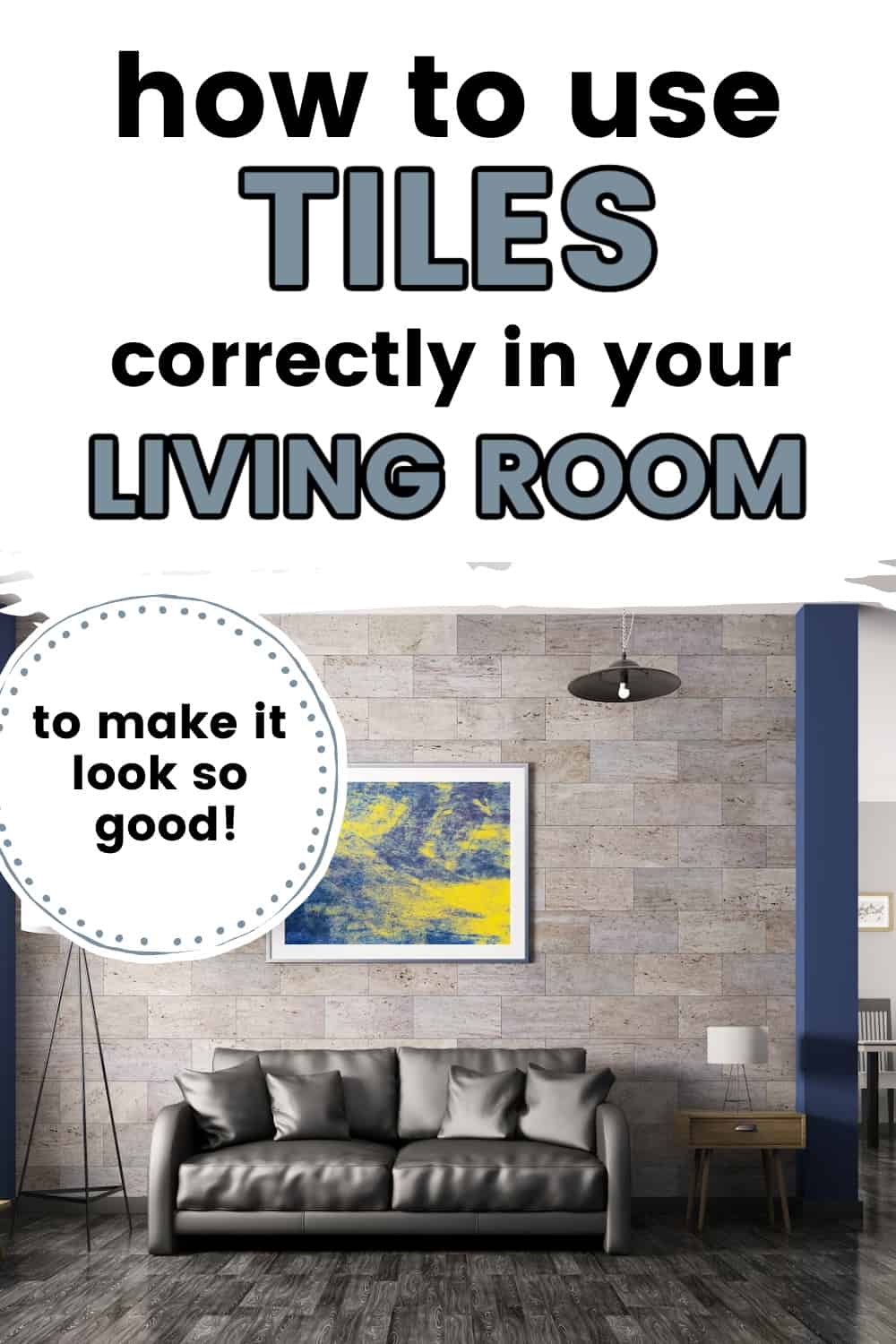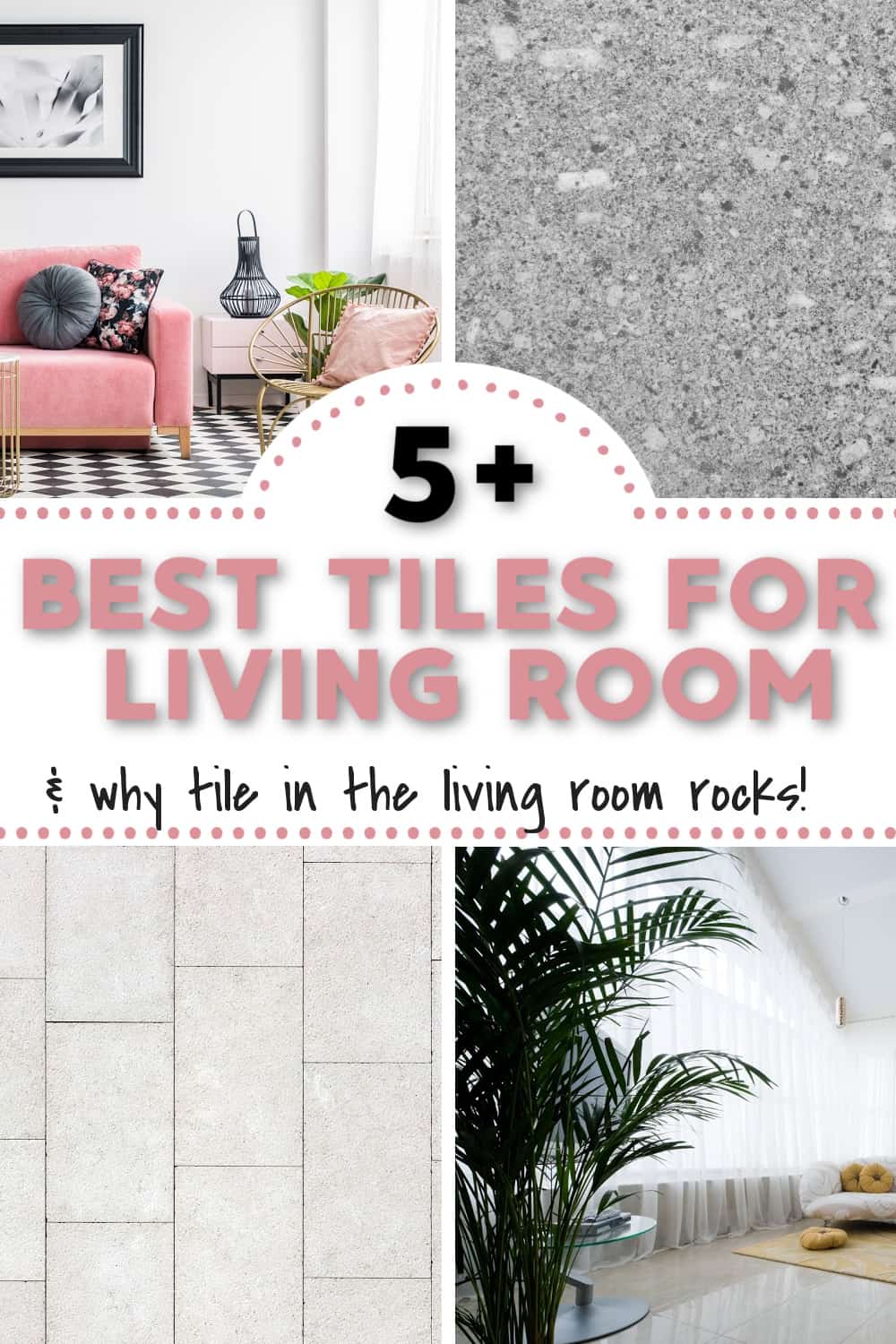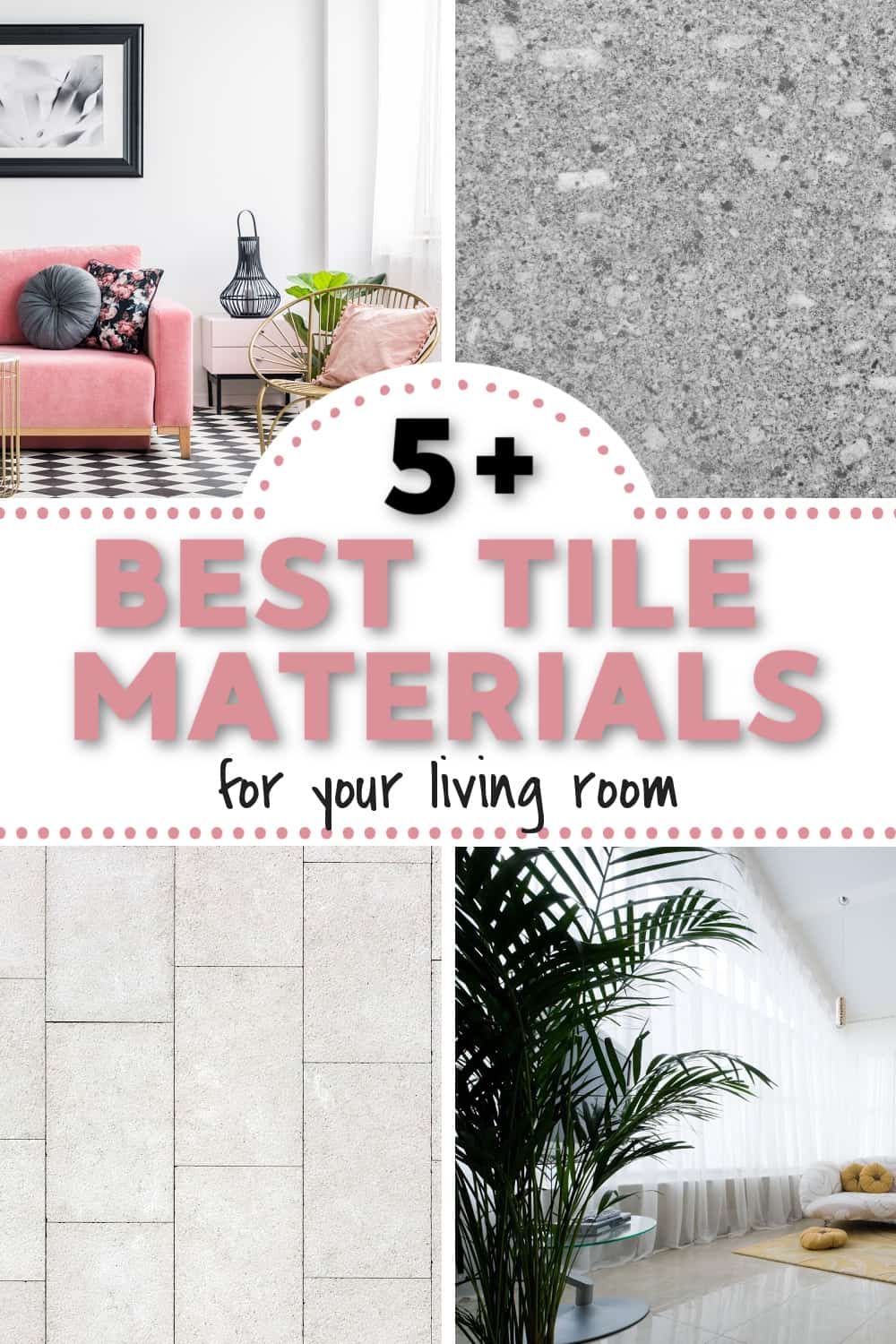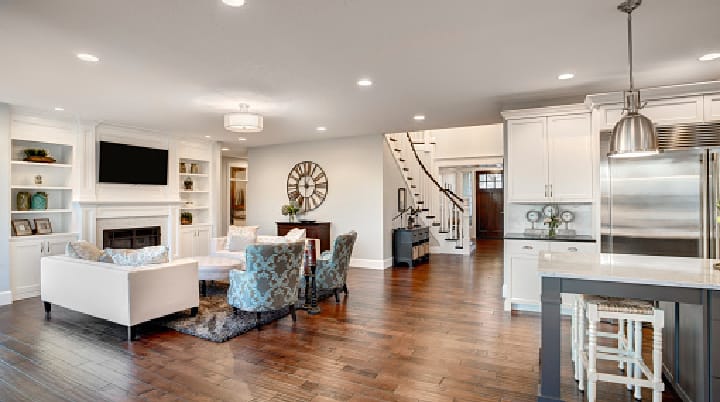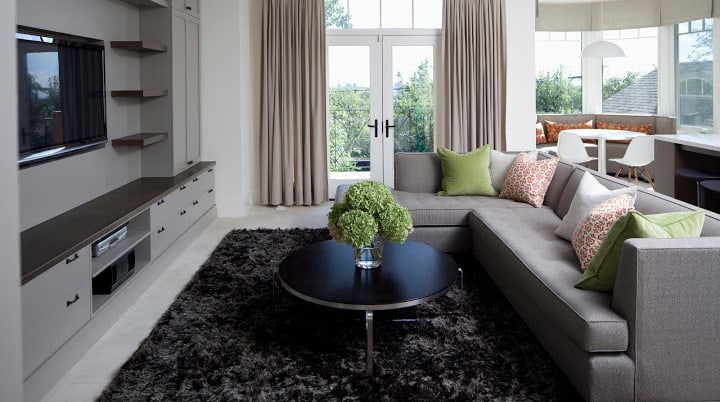If you’re thinking about tiles for your living room- you’re not alone! Tiles are one of the most durable flooring materials along with being scratch resistant and water proof. In other words, there’s a lot of reasons why tiles make sense in the living room.
This post contains affiliate links. Please read our full disclosure here.
This post contains affiliate links. Please see our disclosure for all the details.

Which floor tiles are best for living room?
There are 12 different types of floor tile materials:
- Ceramic– easy to install, clean and budget friendly.
- Porcelain– scratch resistant, waterproof but harder to install.
- Glass– subject to chipping, best used in small amounts as backsplash.
- Cement– high maintenance as they need to be resealed once a month.
- Marble– susceptible to stains, scratches and is high cost.
- Mosaic– these can come in different materials so choose accordingly.
- Granite– highly durable and very low cost.
- Limestone– won’t wear down and comes in variety of earthy tones.
- Travertine– high maintenance, stays cool.
- Quarry– earthy color tones, slip resistant and can be low maintenance.
- Metal– generally used for backsplash, ceilings or accent features.
- Resin– resin tiles are good for areas where water gets splashed or as a backsplash or accent piece.
The best floor tiles for your living room can be narrowed down to:
- ceramic
- porcelain
- granite
- limestone
- travertine
- quarry
How do I choose a tile for my living room?
Based on the 12 different types of tile available, there are some materials more than others that just make sense to put into your living room!
These would be ceramic, porcelain, granite, limestone, travertine or quarry. Here’s how to choose what would be best for you and your living room:
Ceramic tile

Ceramic tiles are made from clay, sand and water. They are mixed together and then pressed into a mold where up to 100,000 pounds of pressure per square inch is exerted. This is what gives ceramic tiles their incredible strength and durability.
Ceramic tiles come in an extraordinary rage of styles and colors which gives you countless options for the style you want.
Advantages of ceramic tiles:
- Water resistant
- Environmentally friendly
- Scratch resistant
- Low maintenance
Disadvantages of ceramic tiles:
- Heavier material
- Cold material
- Hard material
Starting at $0.57/sq foot
Porcelain

Porcelain tiles have been used for thousands of years around the world. Porcelain tiles are also made from clay, sand and water. The difference is that they are fired at extremely high temperatures to create a high density and high durability tile.
Porcelain tiles are also available in a huge variety of styles and colors giving you endless options.
Advantages of porcelain tiles:
- Harder and denser than ceramic tiles
- Stain and scratch resistant
- Moisture resistant
- High breaking point
- Easy to clean
- Low maintenance
Disadvantages of porcelain tiles:
- Requires more foundation work before laying
- A bit pricier than ceramic
Starting from $1.40/sq foot
Granite

Granite is mined in slabs from a quarry and then sent in blocks to manufacturers who use special saws to cut the granite into tiles.
Granite comes in some beautiful natural colors and patterns but you’re limited to what the Earth produces.
Advantages of granite tiles:
- Highly durable
- Scratch resistant
- Naturally beautiful
- Low maintenance
- Increases your homes resale value
Disadvantages of granite tiles:
- Higher price tag
- Harder to install
- Very cold with no in floor heating
Starting from $4.39/sq foot
RELATED: The best Wayfair sectional sofas
Limestone

Most limestone is found and processed in Turkey (along with a lot of other natural stone.)
It’s lighter and softer in color than other options and may not make a great option for heavy foot traffic because it can end up looking worn out faster.
Limestone is absolutely beautiful and a more rare stone which raises the price tag significantly.
There are still a lot of appealing options for limestone– from the hue to the texture.
Advantages of limestone tiles:
- Appearance- it’s gorgeous
- Improve your homes resale value
Disadvantages of limestone tiles:
- Expensive
- High maintenance
- Difficult to install
- Not as durable as other materials
Starting at $10.29/sq foot
Travertine

Travertine is a type of limestone formed by mineral deposits in natural springs. It has unique colors and swirls giving it an interesting look.
Advantages of travertine tile:
- Timeless look
- Non-slip
- Durable
Disadvantages of travertine tile:
- High maintenance
- May show wear and tear because of porousness
Starting at $3.00/sq foot
Quarry

Quarry tiles are made in a similar manner to bricks- by press forming and firing natural clay or shales.
Although the durability and price point may draw you in, the color options may deter you. There aren’t a lot of options and the colors leave something to be desired.
Advantages to quarry tiles:
- Inexpensive
- Highly durable
Disadvantages to quarry tiles:
- Stains easily
- Harder to install
- Requires sealing
- Not a lot of options
Starting at $2.34/sq foot
Are tiles too cold in the living room?
Tiles are certainly a lot colder than other materials you can choose for your floor, such as carpet or hardwood. Something you could consider is installing in floor heating at the same time as your tiles. Then you won’t have to worry about cold floors and still have beautiful tiles (if that’s what you want!)
Is ceramic tile good for living room?
Yes, ceramic or porcelain may be the best options for tile in the living room. This is because of their similar features:
- Price point
- Durability
- Endless color and style options
- Ease of install
Should floor tiles be darker than walls?
Generally, this is a good rule to follow. If the floor is very light, it can appear as if your furniture is floating.
A good suggestion with lighter floors is to use an area rug to pull the room together.
RELATED: Large Living Design Hacks
Which color is best for floor tiles?
Consider which room you’re installing floor tiles- is it big or small? High foot traffic or low foot traffic? Prone to messes or not?
Light colors can make a room look larger. Darker colors can make large rooms or open concept spaces more inviting.
Medium tones or fun patterns are great for hiding dirt and dust accumulation.
Best modern tiles for living room
There are so many great places to find tiles for your living room!
How to select tiles for living room?
Choose tiles that are larger (13×13) as this will lower the amount of grout lines you’ll be able to see.
Select a material that makes sense in your living room-
Do you have pets? Kids? A bigger budget? Time to take of high maintenance tiles?
Answer those questions to narrow down the material you want to go with by looking through the pros and cons of each tile listed above.
How to install living room tile:
There are a few things to keep in mind before moving ahead with tiles. Here are some tips from our flooring expert friends 🙂
- Check to see what your subfloors are made of- are they K3, chipboard or something else?
- The minimum thickness of your subfloor before tiles needs to be 1 1/4 ” thick. If it’s not, you’ll need to reinforce it.
- You can reinforce your subfloor with plywood, corkboard, Schluter Ditra uncoupling membrane, or Protegga Tile Underlayment.
- If you don’t reinforce your subfloor correctly, tile and grout can end up fracturing or cracking.
How to clean living room tile grout?
What flooring is warmest?
The warmest flooring is carpet. Some other warm flooring options are:
Luxury vinyl flooring
Cork flooring
Using a thick area rug
Living room tile or hardwood?
To answer that, you need to compare the differences. Ceramic tiles are a lot cheaper than hardwood and easier to keep clean. However, they will be colder and harder to walk on. But- that may serve you if you have a dog who could scratch up your hardwood.
It all depends on the person and situation.
Do floor tiles make a room colder?
Yes, unfortunately, they do. That’s unavoidable but easily taken care of with in floor heating 🙂

